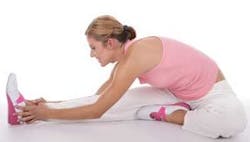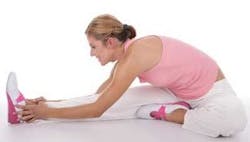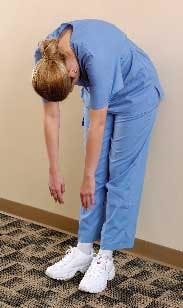Who has tight hamstrings? I do! I do!
by Juli Kagan, RDH, MEd
Last month, immediately after submitting my previous article about eating, exercise, and taking care of “self,” I was asked to write a new article regarding hamstrings. I wasn’t caught off guard by the request, because it seems everyone has tight hamstrings. Fortunately, actually unfortunately, I know the subject all too well, since I have had a nagging biceps femoris for years! Not until I got the muscle really strong did I finally get relief. And still, I am very careful, especially at the muscle’s origin — up near my gluteus maximus (my bottom) — when I stretch.
The hamstrings are actually a grouping of three separate muscles. Two are medial (inner thigh): the semitendinosus and the semimembranosus. The third is the biceps femoris, forming the lateral portion of the thigh. All three muscles originate on the ischial tuberosity (the sitting bone). The hamstrings trifurcate below the knee and insert on the two lower leg bones, the tibia and fibula.
While sitting, you can easily feel your hamstring by planting your heel on the ground and pulling your heel back. It’s even easier to locate the tendons of the hamstrings, behind and just above the knee, when you pull the heel back with your knee partially bent.
The hamstrings have two actions: they bend the knee and extend the hip. Standing up from a seated position is one example of hip extension.
The problem with tight hamstrings and sitting in a chair all day is that the hamstrings become inactive. This means that other muscles have to take over their job and are forced to work overtime. Those other muscles are the erector spinae group and the iliopsoas muscle group. The erector spinae are responsible for “erecting your spine”; that is, holding your posture and back upright.
In addition, the iliopsoas group is responsible for keeping your body in an “L” position while seated, where your trunk is upright but your knees are bent. In other words, the iliopsoas muscles keep your body from falling backward while seated. Ten to 15% of back pain has an iliopsoas trigger point component, and many times this is not recognized by a therapist.1 (This happened to me.)
To make matters worse (as if having a backache isn’t enough), the gluteus maximus is relaxed and therefore unable to exert tension on the spinal muscles around the lower lumbar area and sacrum/hip joint junction. This leads to exceptionally tired low back muscles that after a short period of time simply give up fighting to keep the correct curvature of the lumbar spine.
Isn’t this fun? As seated professionals, we can get tight hamstrings, tired lower back muscles, overworked hip joint muscles, and a fanny that flares just from sitting. What’s a woman (and man?) to do?
One of the best things you can do to improve hamstring strength is to walk — something you already know how to do! Every time your knee bends back and your heel lifts off the ground, you activate the hamstring muscles. If, and only if, your joints can tolerate it, running can be very effective for improving hamstring strength (although running is one of my least favorite exercises due to the impact on the joints of the body).
A second excellent aerobic exercise to improve hamstring strength is biking; however, your feet need to be in cages or in clips in order to pull up into the hamstring.
Another alternative is doing leg curls at a gym on a specific hamstring machine. Better yet, put on a heavy shoe or boot or a one-pound ankle weight and lie on your stomach. Bend your knee toward your bottom (not all the way if you have knee issues) and contract the hamstring at the deepest point.
You can even do this without the shoe/boot/weight; however, you have to really create the contraction on your own. Adding a flexed foot truly honors the hamstring when the knee is bent. This is the best scenario in my opinion, because it is the safest.
I always believe, and studies have shown, that it is best to strengthen a muscle before stretching. Stretching before strengthening appears to create an untoward elasticity and flimsiness of the muscle. Contracting muscle before stretching appears to create muscle stability. Therefore, strengthen first, then stretch.
Stretching
An easy and very safe way to stretch the hamstrings is to lie on your back and bring one knee into your chest, slightly lateral to your ribcage. Allow the knee to bend easily (pulling under the thigh if you have knee issues).
Once your bent knee is close to your body, lengthen your leg straight up toward the ceiling (or at least as straight as possible!) Hold the straight leg at your calf or thigh. Hold the stretch for about three complete breath cycles.
Bend it in and lengthen the leg up to the ceiling three more times. Switch legs.
Another way to stretch the hamstrings is to stand against a wall.
Move your feet approximately 18 inches away from the wall, allowing the entire spine to be against the wall.
Very easily roll your chest over toward your thighs.
Hold your navel/abdomen in and feel a healthy stretch behind the back of the legs. (You’ll also feel this delicious stretch all the way down your tight back!)
Do not go any farther than a “healthy stretch.” Stay here for three full breath cycles.
Then, roll your back up the wall, as if you were pushing two velcro pieces together — one against the wall and the other against your spine. Lengthen your entire spine up the wall.
To set your posture, simply move your heels back to the wall and stand as straight as possible against the wall: neck long, shoulder blades back, upper thoracic rib cage against the wall, small opening in the lumbar region, navel in and up, legs long, and feet parallel.
Feel as if your joints have air shocks that are lifted and light.
Very sadly, many lower backaches are due to tight hamstrings. While stretching, don’t put your body in compromising positions that hurt. Feeling any discomfort is a sign that you are microscopically damaging the muscle or connective tissue fibers — and there are many. Be patient. As always, mind your body and keep moving!
References
1. Rich K. The iliopsoas muscle —the great [back pain] pretender. Article located at: www.chiroweb.com/archves/15/05/24.html.
About the Author
Juli Kagan, RDH, MEd, is devoted to wellness, and passionate about physical and mental fitness, as well as proper posture. Juli is a certified Pilates instructor and a professor of health education. With an energy and enthusiasm that transforms knowledge into practice, Juli wrote: “Mind Your Body: Pilates for the Seated Professional.” Visit her Web site at MindYourBodyBook.com.



